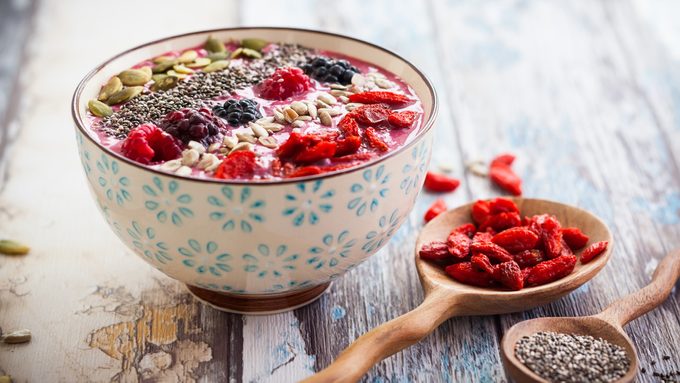These 6 Berries are the Most Underrated Superfoods
Expand your berry repertoire with goji berries, gooseberries, maqui berry and more.

Unusual berries from around the world are joining our familiar ones as nutrient powerhouses.
Goji berries
The berry
A small fruit from the Himalayas, the goji berry (or wolfberry) is widely available dried. Slightly chewy and with a mild flavour, it is used in Chinese medicine to increase longevity.
Why it’s healthy
Gojis provide lots of fibre; a 40-gram serving has 27 percent of the recommended daily intake. It also has some of the highest antioxidant powers of any berry or fruit, according to its Oxygen Radical Absorbance Capacity, a measure developed at the National Institute of Aging in the U.S. of the antioxidant activity of foods.
How to eat them
Mix dried goji berries into trail mix (try our recipe for Walnut Trail Mix with goji or açai berries), sprinkle on cereal or add to recipes that call for raisins or dried cranberries. Or, soak them in a bit of water overnight and add to smoothies. Goji berries and juice are available in natural-food stores. (They are even available covered in dark chocolate.)
Elderberries
The berry
Elderberries are small, bluish purple berries that are grown across Canada. The best place to pick them up is at your local farmers’ market.
Why it’s healthy
Elderberries are rich in antioxidants and have long been used in treatments for the influenza virus. They also stimulate cytokine production, which helps reduce inflammation and improve immune function.
How to eat them
These berries can’t be eaten raw like blueberries or raspberries; instead, they need to be processed in some way – either cooked or tinctured. You’ll often find elderberry served up as a tea or in herbal tea blends specifically for immune health or cold and flu formulas. You can tincture elderberries with vodka (hello, cocktail mixer!) and add it to your own Canadian-inspired cocktail or take it as a tincture for cold and flu prevention.
Açai berries
The berry
The black-purple açai (ah-sigh-ee) grows on açai palm trees in the Amazon rainforest, and looks like a giant blueberry. Since it deteriorates quickly after being picked, açai is available at natural-food stores as juice or fruit pulp.
Why it’s healthy
The açai berry is high in antioxidants and fatty acids that help lower LDL (‘bad’) cholesterol, low in calories, and contains high levels of dietary fibre. A 2008 U.S. study found that açai extract inhibited the growth of cell cultures, indicating it may have potential to fight cancer cell growth.
How to eat them
Drink açai juice pure or blended with other fruit juices, or add to a morning smoothie. (Try it in our Blueberry Acai Smoothie Bowl.) Also look for Belizza açai sorbets and commercial smoothies and probiotic drinks at many natural-food stores.
Cape gooseberries
The berry
A biological cousin of the tomato, this gooseberry indeed does look like a small yellow cherry tomato that’s covered by a brown husk. With a sweet pineapple-like flavour, the fruit (also called Inca berry or ground cherry) is native to South America, but varieties are grown here. Look for it in grocery stores and farmers’ markets.
Why it’s healthy
High in protein, this berry also contains vitamins C, A and B12. A recent Brazilian study found it’s a good source of carotenoids, which may help protect against cancer and heart disease.
How to eat them
Eat cape gooseberries as a refreshing fruit snack, toss in fruit salads, or bake into mixed berry crisps or pies. Add the dried berries to trail mix or toss with a green salad.
Nergi fruit berries
The berry
Nergi fruit look like grapes on the outside. On the inside, it’s more like kiwi. And the taste is kind of a mix of both. The berries, a.k.a. kiwi berries, are grown in France, Spain, Portugal, Italy and Ukraine, but they originate and are produced in Asia. And they are harvested in August and September, which is why the fall is the best time to buy them.
Why it’s healthy
As a fruit, they’re low in calories – 52 calories for about 10 berries. (One is about the size of a small plum.) They’re a good source of fibre, vitamins C and E, and are being touted for their energizing properties.
How to eat them
You can wash them and snack on them as you like and you can eat the skin (no need to peel them). You can also add them to smoothies, salads and pretty much any dish you would add fruit to. (Negri fruit skewers are super easy to make and bring to a party.)
Maqui Berry
The berry
Maqui is a deep purple berry native to Chile. It’s long been a staple in the diet of the indigenous people of Central and Southern Chile, called the Mapuche.
Why it’s healthy
Maqui berry is incredibly high in antioxidants and are said to boost energy, reduce inflammation and support the immune system. Maqui berry powder is also being used in skincare products!
How to eat them
You can find maqui berry powder in natural health food stores. It’s been freeze dried and pulverized into a powder to ensure that the vitamins, minerals and antioxidants found in the berry are not degraded. Try it in a smoothie, sprinkled on yogurt or mixed in chia seed pudding. (Try it in our Honey Roasted Fig Chia Seed Pudding recipe.)
While these super berries are bound to become a regular part of your diet, don’t forget about the incredible health benefits of old favourites like blueberries, strawberries and cranberries —all of which are grown right here in Canada.
Don’t miss out! Sign up for our free weekly newsletters and get nutritious recipes, healthy weight-loss tips, easy ways to stay in shape and all the health news you need, delivered straight to your inbox.




